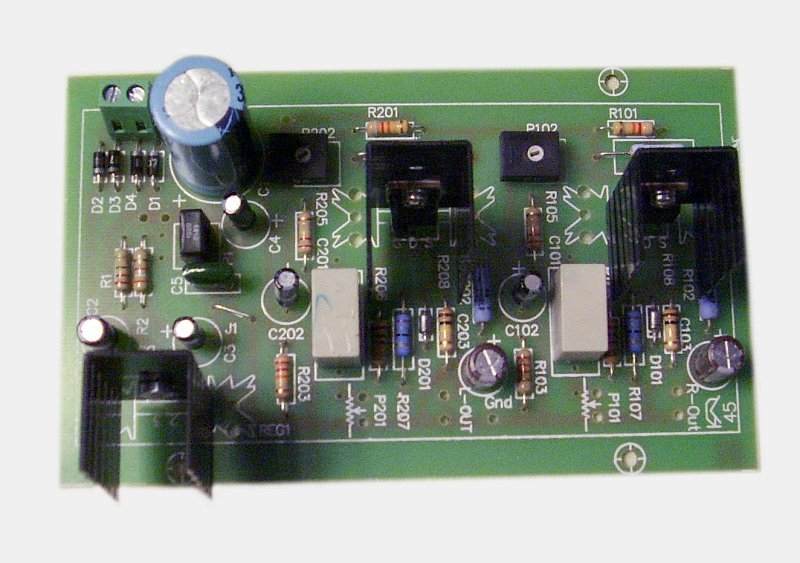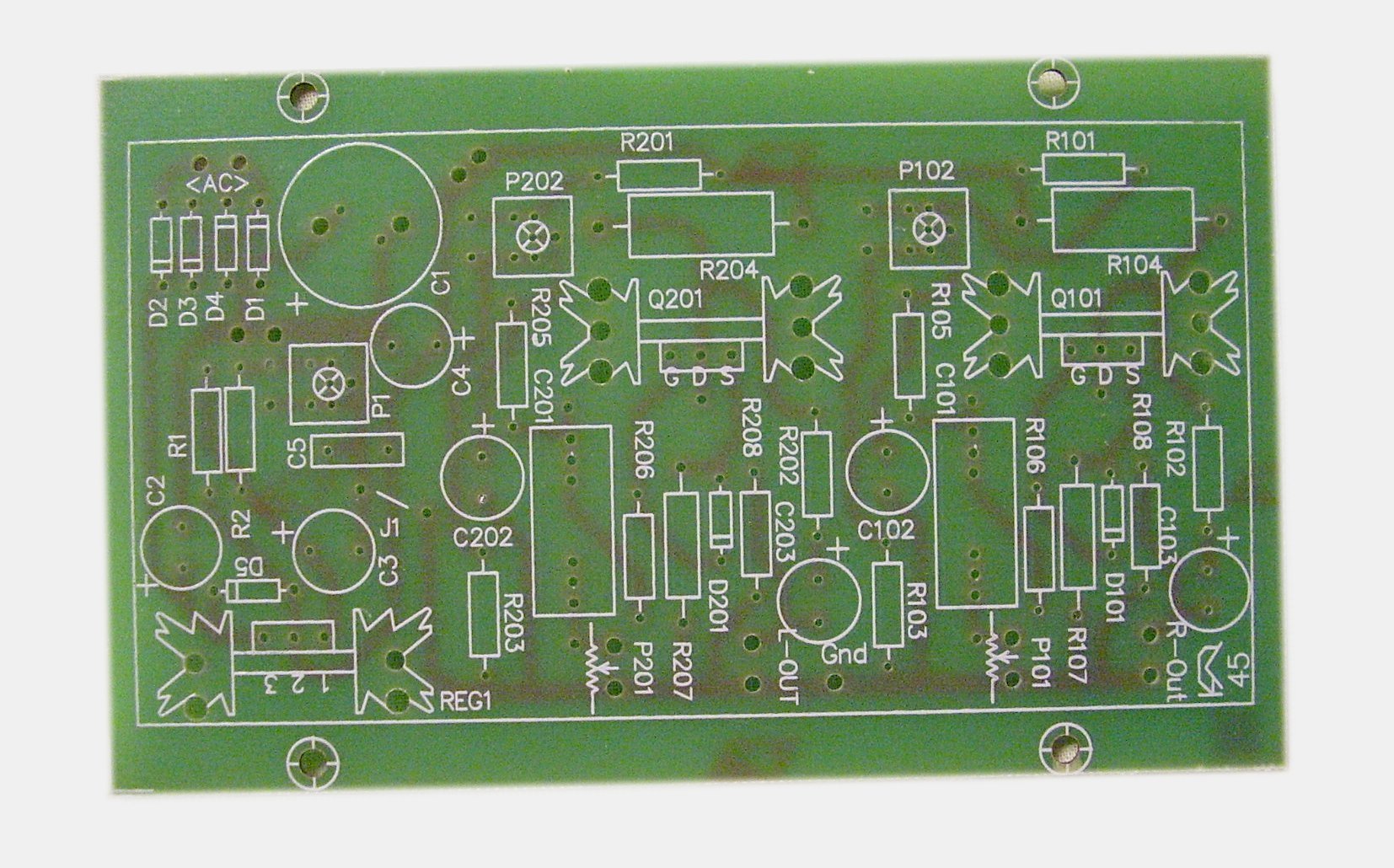Tag: preamp
31 December 2013 » Preamp
Current choices
My hunch is a buffer will end up being the system preamp.
2 9v batteries for breadboard
Custom NiMH Battery Pack: 18V 3.8 Ah - $78
Multi-Current Universal Smart Charger for 9.6V - 18V NiMH/Nicd Battery Packs
Sparkfun - Power Connector Basics https://learn.sparkfun.com/tutorials/connector-basics/power-connectors
Boozhound Labs JFET Buffer kit
$19.70 2.1x5.5 plug Mouser Part #: 709-GSM40A24-P1J Manufacturer Part #: GSM40A24-P1J Manufacturer: Mean Well Description: Desktop AC Adapters 40W 24V 1.67A Medical Power Supply
- Requires external 12-24VDC power supply
- Assembled board dimensions (inches): 4.125 x 2.5 x 1.625 (height with standoffs)
$27.00 1000 mAh battery pack made of 20 pcs (2x10) NiCd AA cells
$78 http://www.batteryspace.com/Custom-NiMH-Battery-Pack-18V-3.8-Ah-15-x-4/3A-68.4-wh-Hump-pack.aspx Customized 18V 3.8Ah NiMH battery pack is made of 15 pcs High quality Powerizer brand NiMH 4/3A cells and in nested configuration Capacity: 3800 mAh
$27 http://www.batteryspace.com/Multi-Current-Universal-Smart-Charger-for-9.6V—18V-NiMH/Nicd-Battery-Pack.aspx Universal Fast Smart Charger is designed for charging any NiMH / NiCd Battery Pack from 9.6V - 18V, for 8 to 15 cells pack.
http://www.mouser.com/ProductDetail/Vishay-Semiconductors/TLLR5400/?qs=sGAEpiMZZMtmwHDZQCdlqS9Zeqr1KrsM5usDJZZF%252bjs%3d power indicator led http://www.vishay.com/product?docid=83030 TLLR540., TLLY540., TLLG540. product information Low Current LED in Ø 5 mm Tinted Diffused Package
Forward Current: 2 mA Forward Voltage: 1.9 V LED Size: T-1 3/4 Packaging: Bulk Lens Dimensions: 5 mm x 5 mm x 7.7 mm
http://led.linear1.org/1led.wiz
18v source. 8.2k 1/8w resistor. 1.9v@2ma
http://www.mouser.com/ProductDetail/VCC/CLB300RTP/?qs=%2fha2pyFaduit04BEGf7JTs%2fmxx%252bLC5g%2foRv8v%2fPTRiU%3d VCC CLB300RTP Description: LED Lenses Red Fresnel Lens Cliplite 5mm
MOUNTING: Mounts in a .250 .002 [ 6.35mm .05] panel hole on .375 [9.5mm] centers.
Panel thickness .031 [.8 mm] to .250 [6.35mm]. Panel hole should be deburred, but not chamfered.
ASSEMBLY: Insert lens through panel hole, (for thin panels less than .188 [4.75mm] thick, slide 2. SPC 125 spacer on back of lens), and insert LED into lens.
jBoZ parts
boozhoundlabs on ebay
- 2sk170 JFET transistors - Toshiba - matched quad - 1mA match - GR - 2SK170GR
- jsn@boozhoundlabs.com
- $11.98 including shipping
Parts Express
Dayton Audio DMPC-10 10uF 250V Polypropylene Capacitor 2 X $4.33
25K Audio Taper Potentiometer 1/4” Shaft 2 x $1.55 Part # 023-612
Neutrik NF2D-2 RCA Jack Connector D-Series Red/Nickel 2 x $3.59
Neutrik NF2D-9 RCA Jack Connector D-Series White/Nickel 2 x $3.59
Mouser
Mouser - Eagle Plastic Devices Battery Holders, Clips & Contacts “I” 4” 26 AWG 2 x $.40
Mouser - Eagle Plastic Devices Battery Holders, Clips & Contacts 9V BATTERY CLIP VERT
Sparkfun
Sparkfun - Wire Strippers 30AWG TOL-08696 $4.95
Description: These are good quality 6” wire strippers with 6 gauge settings. We really wanted to stock these because they strip 30AWG wire wrap wire nicely as well as the standard 22AWG hook up wire.
Features: 30, 28, 26, 24, 22, 20 AWG settings
Sparkfun - 30 AWG Wire Wrap Wire - Black $8.95
Bias and gain setting of jBoZ
Nelson Pass - situation with the gain, bias, and resistor values
Since the question has come up and not answered, the situation with the gain, bias, and resistor values is as follows.
The device is self biased, and we want the highest value of bias possible for lowest distortion which makes us want to use a low value Source resistor to ground.
At the same time, it would be nice to not have too much gain by virtue of that Source resistor value. The apparent resistance of the JFET is about 50 ohms, so the gain into a 10 K ohm load is about 1000 / 60 which is about 24 dB.
We can get lower gain, but the distortion will increase - it’s all a trade-off. I didn’t make any effort to exactly optimize these values - they were just thumbnail calculations.
Nelson Pass - best distortion numbers from a 16V supply
I measured the circuit this afternoon, and it came out mostly as expected, but the best distortion numbers came from a 16V supply value.
Preamp
MooseFET
Original MosFET Bride of Zen
Due to its extreme simplicity, the Zen amplifier’s interfaced needs to be indulged a bit, both at the output and also at the input. With respect to its output, it is designed for an 8 ohm load with an efficiency of 94 dB or greater. I have driven the Zen into Thiel 3.6 loudspeakers, 88 dB efficient at 2.3 ohms, but the result is not pretty. With a pair of Klipsch speakers it will throw off its mild mannered disguise and behave like a party animal.
The Zen amp input makes a preamp do a little more work than usual. Depending on the specific input values, its input impedance is typically 4.75 KOhm, and it needs about 2.5 volts input to drive it to full output. Its gain is about 15 dB, which is 10 dB less than most power amps and it requires more signal from the preamp for equivalent levels.
The point of a preamp circuit here is to function as a gain circuit with a high input impedance, a low output impedance, and a volume control. This preamp has a 50 KOhm input impedance, variable gain to about 15 dB, and will deliver the 2.5 volts at .1% distortion or less.
JFET Bride of Zen by Nelson Pass
BoZ thread on diyaudioprojects


Volume Control
We will place the volume control at the output of the circuit, giving us a higher output impedance than is typical. Depending on the position of the volume control, the output impedance will range from 0 to 1.5 KOhms.
Normally you see the volume control potentiometer at the input to the preamp circuit, and in this way you can insure that the input will not be overloaded. Placing the potentiometer at the output has two advantages, however, the first being that all circuit noise will be attenuated as the volume setting is reduced. Placing the volume control at the output allows the input of the gain stage to look directly at the source. This improves the bandwidth and distortion of the circuit by providing a lower RC figure for the input capacitance of the MOSFET. If you desire to place a potentiometer at the input of the circuit, feel free to do so before the input coupling capacitor in place of R107.
Because the input to the Zen amplifier is a resistor operating into a virtual ground summing junction, it is insensitive to a resistive source impedance. The gain of the amplifier will alter by the addition of the source resistance, but the distortion and bandwidth performance will not change appreciably. A circuit driving the Zen amplifier need not have a particularly low output impedance, as long as it is resistive in character.
Is a maximum 1.5 KOhm source impedance a problem? Not in my experience, as long as it is passive in character, as in the case of this circuit which has no feedback. You could conceivably see some rolloff at the top end, but even 1000 pF loading will only take the bandwidth down to 100 KHz.
Bride of Zen FET Preamplifier - Aren van Waarde
The Bride of Zen, designed by Nelson Pass and described in The Audio Amateur, 1994, is a very simple line-level preamplifier which contains just one medium-power MOSFET per channel. It is meant to be used together with the Zen (or Son of Zen) single-ended MOSFET power amp. A complete description of the BOZ can be found at http://www.passlabs.com.Mr.Pass has given a very lucid account of the design philosophy, construction and alignment (the only alignment consists of adjusting the quiescent current which should be 40 mA per channel at a supply voltage of +60V). The lay-out for a printed circuit board can be downloaded from Passlabs.
Zen Amp and Bride of Zen Preamp
Bride of Zen - SE preamplifier with only a single active device (MOSFET) per channel
- allelectronics - Solid Hook-Up Wire, 25 Foot Rolls
- jameco - Wire Wrap Kynar Red 100 Feet 30AWG
- allelectronics - 1-TERMINAL STRIP
- allelectronics - 1 LUG 1 GROUND TIE POINT
- allelectronics - 2 LUG 1 GROUND TIE POINT
- allelectronics - 8-LUG TIE POINT STRIP
- surplus-electronics-sales - 5 Lug Terminal Strip
- Surplus Sales - Terminal Strips: Phenolic Lug Type - Old Fashioned
Forums
23 January 2014 » Classic Valve Moosefet
Classic Valve MooseFET Pre



diyaudioprojects MooseFET Preamplifier
| Pre. Part | Description | Geek Order | Coot Order |
|---|---|---|---|
| C1 | United Chemi-Con 3300uF 35V LXZ | 565-2001-ND | 565-1593-ND |
| C2 | United Chemi-Con 47uF 50V LXZ | 565-2004-ND | tbd |
| C3, C4, C102, C202 | United Chemi-Con 10uF 50V KZE | 565-1702-ND | tbd |
| C5 | Panasonic 0.1uF, ECQ Polyester film | EF1104-ND | P4725-ND |
| C103, C203 | Nichicon 47uF 25V Muse Cap KZ | 493-3189-ND | tbd |
| C101, C201 | Vishay/BC Components MKP .22uF 63VDC 2% | BC2062-ND | tbd |
|   | |||
| R1 | Yageo 220 ohm carbon film resistor | 220H-ND | tbd |
| R2 | Yageo 3.9K carbon film resistor | 3.9KH-ND | tbd |
| P1 | Bourns 200R Linear Single Turn Cermet Trimmer | 3362P-201LF-ND | tbd |
| R101, R201 | Yageo 82K carbon film resistor | 82KH-ND | tbd |
| R102, R202 | Matsushita (Panasonic) 470R, 2W Metal Oxide resistor | P470W-2BK-ND | tbd |
| R103, R203 (for IRF510) | Yageo 20K carbon film resistor | 20KH-ND | tbd |
| R103, R203 (for IRF710) | Yageo 22K carbon film resistor | 22KH-ND | tbd |
| R104, R204 | Matsushita (Panasonic) 120R, 2W Metal Oxide resistor | P120W-2BK-ND | tbd |
| R105, R205 | Yageo 220K carbon film resistor | 220KH-ND | tbd |
| R106, R206 | Yageo 150 ohm carbon film resistor | 150H-ND | tbd |
| R107, R207 | Matsushita (Panasonic) 18R, 2W Metal Oxide resistor | P18W-2BK-ND | tbd |
| R108, R208 | Yageo 100K carbon film resistor | 100KH-ND | tbd |
| P102, P202 | Bourns 5K Linear Single Turn Cermet Trimmer | 3362P-502LF-ND | tbd |
|   | |||
| D1, D2, D3, D4, D5 | 1N4007 Diode | 1N4007FSCT-ND | tbd |
| D101, D201 | 1N4739A, 9.1V Zener Diode | 1N4739ADICT-ND | tbd |
| Q101,Q201 | MOSFET N-CH 100V 5.6A TO-220AB | <IRF510PBF-ND/td> | IRF510PBF-ND |
| REG1 | ST Microelectronics LM317T Regulator | 497-1575-5-ND | tbd |
|   | |||
| FB101, FB201 | Ferrite Bead | M8702 | tbd |
| Heatsinks | Bolt on heatsink | HS104-2-ND | tbd |
| J1 | Use a clipped lead from another component | N/A | tbd |
Tags
- linux
- debian
- diy
- arduino
- cellphone
- turntable
- antenna
- diy_audio
- led
- rune_audio
- tuner
- chipamp
- raspberry_pi
- bluehost
- am
- mpd
- developers_to_watch
- beaglebone
- stereo_system
- headphone_amp
- i3wm
- fm
- arch_linux
- bluetooth
- nas
- preamp
- git
- javascript
- sql
- ti_cc_3000
- wifi
- reactor_safety
- volumio
- raspbian
- pptp
- Debian
- keyboard
- portable
- lp_storage
- firefox_phone
- firefox_os
- repair
- radio
- moteino_home_automation
- xmonad
- gitlab
- rails
- rails-api
- windows_os
- vm_host
- virtualbox
- electronics
- cubox
- rhombic_antenna
- diy_li_ion_battery_pack
- survival
- music_player
- headphones
- robotics
- welcome
- speaker
- subwoofer
- tear_drop_trailers
- philips_cd935
- diy_cabling
- laptop
- pickup
- hurricane_lantern
- coding
- cd_player
- bluez
- programming
- headset
- hardware_hackers
- arduino_ide
- tube_audio
- porch_steps_led
- ebay
- fm_transmitter
- coax_power_plug
- recipe
- vpn
- arduino_radio
- tv
- gammu
- stereo_receiver
- seamonkey
- thunderbird
- vinyl_lp
- cleaning
- hardware
- rs232
- max232
- gogs
- job_hunt
- phusion_passenger
- tuned_loop
- firefox
- icemonkey
- job_skills
- webmail
- spam_assassin
- irc
- security
- pc_audio
- green_chile
- moosefet
- usb
- ajax